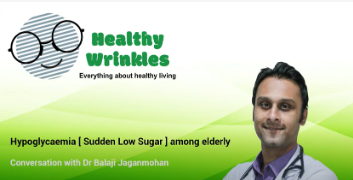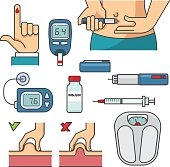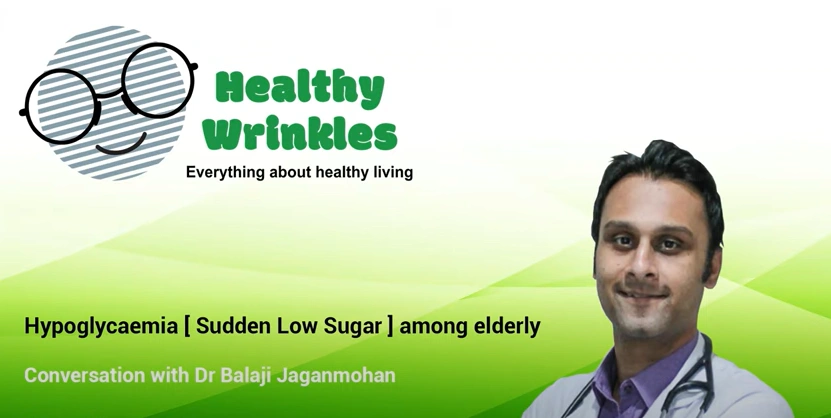Understanding "Hypo" in Diabetes: A Comprehensive Guide to Hypoglycemia
01-10-24
Understanding "Hypo" in Diabetes: A Comprehensive Guide to Hypoglycemia
Dr. Balaji Jaganmohan, a renowned diabetologist at Apollo Hospitals, in a conversation with Healthy Wrinkles, explains understanding Hypo in diabetes. Today, we're delving into the world of diabetes and exploring the intriguing concept of hypoglycemia. So, let's start our journey to uncover the mysteries of low blood sugar! Watch our YouTube playlist on diabetes(madhumeha) to know more.
What is Hypoglycemia?
Hypoglycemia, often referred to as "hypo" in the world of diabetes, is a condition where blood sugar levels drop below a specific range. To put it simply, when your blood sugar levels dip to an uncomfortably low point, you've entered the realm of hypoglycemia. But where's the line drawn? According to international guidelines, this threshold is typically set at 70 milligrams per deciliter. However, it's worth noting that when blood sugar levels plunge to around 55 milligrams per deciliter, your body's defense mechanisms spring into action. This is when certain counter-regulatory hormones come into play, working tirelessly to rectify the situation and bring your blood sugar back to a safe level. These hormones include glucagon, epinephrine, cortisol, and growth hormone. Learn more about diabetes in seniors from our experts.
The Role of Counter-Regulatory Hormones
When your blood sugar levels hit that critical 55 milligrams per deciliter mark, it's primarily the hormone known as epinephrine that takes the lead. This hormone is responsible for initiating an adrenergic symptom response, which can manifest in a variety of ways. Let's have a closer look at some of the warning signs and symptoms associated with this crucial stage of hypoglycemia
1. Feeling Giddy
As your blood sugar levels drop, you might experience a sense of giddiness. It's as if the world around you is spinning, leaving you feeling light-headed and disoriented.
2. Overwhelming Hunger
Your body craves glucose to fuel its functions. When blood sugar levels plummet, your brain sends out signals that intensify your hunger. This can be a voracious, gnawing sensation that's hard to ignore.
3. Shaking Hands and Legs
One of the most distinctive signs of hypoglycemia is the trembling of your hands and legs. It's like an internal earthquake, a clear indication that your body is in distress.
4. Profuse Sweating
Sweating is your body's way of cooling down, but when your blood sugar is low, you might start sweating excessively. Your skin feels clammy, and you may even break out into a cold sweat.
5. Speech Difficulties
Speaking might become a challenge during a hypoglycemic episode. You may experience stammering, difficulty forming coherent sentences, or even find it challenging to express yourself verbally. These symptoms serve as an early warning system, alerting you to the fact that your body needs help. It's your body's way of saying, "Hey, something's not right – let's fix it!" So, when you experience these signs, it's time to take action and correct your low blood sugar levels promptly.
The Danger Zone Blood Sugar Below 30
Now, let's talk about a situation that's even more critical. When your blood sugar levels plummet below 30 milligrams per deciliter, it's like entering the danger zone of hypoglycemia. At this stage, you're at a significantly higher risk of experiencing severe complications. In fact, at this level, there's a real risk of going into a coma, or what we medically term as a "neuroglycopenic" symptom. This is a severe state where you might lose consciousness, and your cognitive functions can be profoundly affected. To make matters even more serious, individuals with blood sugar levels below 30 often require third-party assistance. Read more about the role of geriatrician in managing chronic health conditions. It becomes imperative for someone else to step in and provide the necessary care and support to address this life-threatening situation.
Managing Hypoglycemia Tips and Strategies
Now that you understand the gravity of hypoglycemia, it's essential to know how to manage it effectively. Whether you have diabetes or not, these strategies can be lifesaving.
1. Carry Quick-Acting Carbohydrates
Always have a source of rapid-acting carbohydrates on hand, such as glucose tablets, fruit juice, or hard candy. These can quickly elevate your blood sugar levels in case of an emergency.
2. Regular Blood Sugar Monitoring
Keep a close eye on your blood sugar levels, especially if you have diabetes. Frequent monitoring can help you catch and address hypoglycemia early.
3. Balanced Diet
Maintain a balanced diet with consistent mealtimes. Avoid skipping meals, and ensure your diet includes a mix of complex carbohydrates, proteins, and healthy fats. Read diet plan for diabetic seniors.
4. Medication Management
If you're on medication for diabetes, ensure you take it as prescribed by your healthcare provider. Avoid overmedicating, which can lead to low blood sugar.
5. Education
Learn about the specific signs and symptoms of hypoglycemia and share this knowledge with your loved ones. They can assist you in case of a severe hypoglycemic event. Watch more videos on Know Your Medicines that cover the most popular medicines.
6. Emergency Plan
Develop an emergency plan in collaboration with your healthcare provider. This plan should outline steps to follow in the event of severe hypoglycemia. View Doctor At Home.
7. Medical ID Bracelet
Wearing a medical ID bracelet that indicates your condition can be a lifesaver in emergencies, ensuring that medical professionals are aware of your needs. Hypoglycemia is a serious condition that demands vigilance and preparation. By adopting these strategies, you can effectively manage your blood sugar levels and reduce the risk of hypoglycemic episodes.
Conclusion
In the realm of diabetes, hypoglycemia is a critical concern that can have severe consequences if left unaddressed. Recognizing the warning signs and understanding the role of counter-regulatory hormones like epinephrine is crucial to your health and well-being. Remember that hypoglycemia is not exclusive to individuals with diabetes; it can affect anyone. Therefore, it's essential to be informed and prepared. By following the strategies mentioned above, you can navigate the challenges of hypoglycemia and ensure that your blood sugar levels remain within a safe and healthy range.
Whether you are searching for informative articles, or looking for healthcare providers, Healthy Wrinkles is an excellent resource for all your senior care needs. We also have a great compilation of all the medical expert talks for healthy aging on Healthy Wrinkle YouTube channel.
"Join the cause and make a difference in a senior's life - share your knowledge about local senior care resources today!"
Disclaimer: Healthy Wrinkles does not recommend or offer any medical diagnosis, treatment, or advice. The information provided here is only for the awareness of disease or ailment among individuals, caregivers, and the public. The advice of doctors, licensed professionals, or therapists who are knowledgeable about your particular situation should always be sought before using the information provided here. It should also not be used in the event of a medical emergency or for the diagnosis or treatment of any medical condition. If you want urgent assistance, contact a qualified medical professional. Additionally, the information represents the author's views and not those of Healthy Wrinkles.
#hypo #diabetes #prevention #diabeticcare #diabeticseniors #healthyaging #healthywrinkles #diabetescontrol #diabetesmanagement #madhumeha















